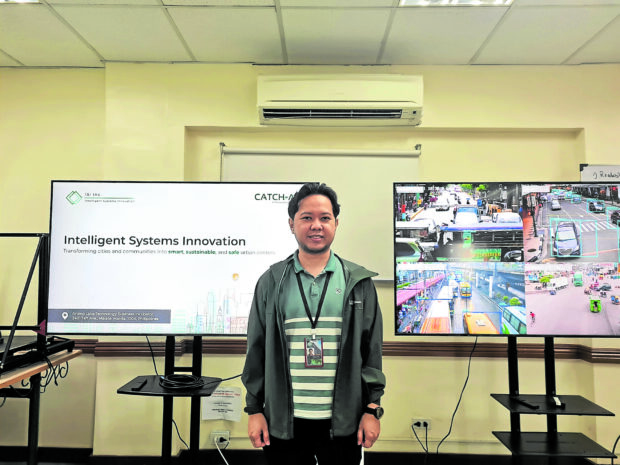La Salle engineers develop AI-aided tech to help manage traffic

AIMING FOR ‘SMART CITIES’ De La Salle University associate professor Kerwin Billones heads the team of engineers running Catch-All, the AI-powered traffic monitoring system. —KRIXIA SUBINGSUBING
At De La Salle University (DLSU) in Manila, where the traffic outside often builds up into a monster jam especially on Taft Avenue, a small team of engineers offers some help to tame it—using artificial intelligence (AI).
Intelligence System Inc. (ISI), a startup company incubated within the university’s Animo Labs, has developed an AI-powered system that can detect erring motorists and analyze traffic data.
Called Catch-All, the system hopes to make traffic management smarter and more efficient and ultimately reduce travel time around the metropolis, said Kerwin Billones, ISI’s chief executive officer and cofounder.
“There’s a lot of value in these systems especially when we’re talking about smart cities,” Billones told the Inquirer. “It’s not only about making intelligent devices but also improving the quality of life.”
The Catch-All system has been operational since 2019 and is funded by the Philippine Council for Industry, Energy and Emerging Technology Research and Development, a body under the Department of Science and Technology.
Article continues after this advertisement‘Visual experience’
The year it was unveiled, the Japan International Cooperation Agency released a report saying that Metro Manila was losing an estimated $22.9 billion yearly in terms of revenue and wasteful expenses due to traffic congestion, and that the figure could to swell to $39.3 billion by 2035.
Article continues after this advertisement“The thing about traffic is that it’s something we understand based on visual observation or experience,’’ he said.
But for a more “data-driven” approach, the ISI team set out to develop a tool that can help the country’s policymakers in urban traffic planning and management, Billones said.
The resulting system tapped the potentials of AI, but not in the way it is being used nowadays in more headline-making applications like ChatGPT and Bard.
Catch-All is powered by a different strand of AI called computer vision. As Billones explained, “it tries to mimic the human eye and how it is able to translate the things it sees and differentiate them.”
“Right now, most traffic bureaus in the country only know how to capture video data, but there is no action, no intelligent insight,” he said. “But with AI, we can employ some form of intelligence and it becomes a more proactive approach to capturing the data and generating insights.”
Analytics
The system is still fairly straightforward: It gathers data through traffic cameras, which are then fed into an AI engine that can read license plates and differentiate vehicles.
Using the information, it can then generate a violator list, an apprehension ticket or a report analyzing the traffic patterns in the particular observed area.
It can even estimate the level of carbon emissions based on the vehicles’ model, though the ISI team has yet to fully explore this feature, Billones said.
The system can generate historical and predictive analytics on important traffic data: What time is congestion at its worst? What’s the underlying “vehicle behavior” behind it?
This is different from the methods used by other traffic agencies, like the Metropolitan Manila Development Authority, he said.
“They still do, for example, manual traffic counting surveys where they deploy employees to count vehicles,” he said. “[But here is] an opportunity to also automate the process where we do not necessarily aim to replace humans but augment their productivity.”
At present, local governments—Manila and Makati in the capital region, Roxas City in Capiz and General Santos City in South Cotabato—are using this technology.
In General Santos City, for example, the system has enabled local authorities to more accurately identify “colorum” or unauthorized tricycles that are plying the streets in growing numbers.
Low cost
Shopping malls and real-estate developers have also expressed interest in Catch-All and how it can help plan or predict traffic flow in their areas.
The software is being offered as a service at P10,000 per month or P120,000 a year.
According to Billones, the cost of the system itself is considerably low, but it’s the needed data-gathering infrastructure—like the setup of a camera network—that is capital-intensive.
He expressed hope that more local governments would give Catch-All a try and “help uplift the profile of Filipino engineers” capable of harnessing AI and other emerging technologies. INQ